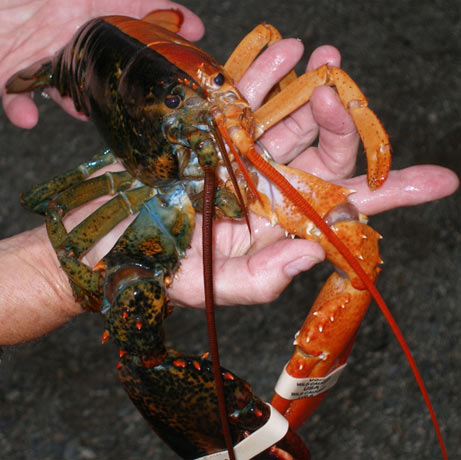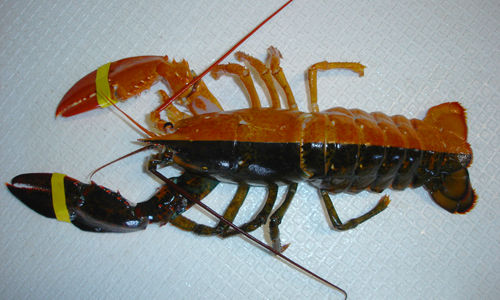tags: lobster, two-toned lobster
Last week, an unusual two-toned lobster was captured off Newport, RI. This lobster is so rare that a person only has between a 1 in 50 million to 100 million chance of capturing one. By comparison, the odds of finding a blue lobster are about 1 in four million. However, despite these incredibly long odds, one just like it was captured in Maine in 2006 -- an indication of the number of lobsters that are taken every year?
Basically, the color of a lobster's shell is a mix of yellow, red, and blue, a combination that results in the usual brownish-green color of most lobsters. The lack of blue and yellow resulted in the unusual surprise -- a bright red half, resembling an already cooked lobster. This two-toned lobster has half its body of normal, mottled brown color while the other half is a bright red -- a result of a genetic mutation. The two sides of this lobster developed independently with the red side having a lack of the blue pigment crustacyanin. The mutuation causes a unique appearance.
"Selection for pimentation starts at the first cell division of the embryo. Genes from one pigment went to one cell while the others went to the other. All subsequent divisions carry the same information," said Ed Baker of the Office of Marine Programs at the University of Rhode Island.
Normally, Lobsterman Jim Mataronas IV, who captured the rare lobster, keeps unusual lobsters on display to delight his walk-in customers. However, this is a special circumstance.
"We'll give it to a good home." He mentioned the Mystic Aquarium in Connecticut and Boston's New England Aquarium.
Hey, an image of yet another two-toned lobster! Clearly, they aren't as vanishingly rare as one might suspect.
Cited story
Featured image: 2006 two-toned lobster captured in Maine.
- Log in to post comments




The plural of lobster, is lobster. Did you not know that?
Judging by the username he/she/it isn't too concerned about the details.
Mobius, please visit with a dictionary. The plural of lobster is "lobsters."
http://www.websters-online-dictionary.org/definition/lobsters
Judging by your comment you are an incredibly snarky person.
Being a contrarian saved his life!
Amazing. I am suprised that lobsters such as this survive long enough to become that large.
There is (was?) a project to breed and release more blue lobsters:
http://kodiak.asap.um.maine.edu/lobster/library/publications/bulletin/v…
Whilst the above link doesn't say why the project exists (existed?), my recollection from when I first read about it yonks ago is because blue lobsters are apparently considered even tastier, and hence, combined with the rarity, fetch even higher prices.
Which makes me wonder: What does a "pre-cooked" ;-) (red) lobster taste like? (I assume there are "fully pre-cooked" (all red) lobsters in addition to the "half-cooked" ones?)
Also, the above link claims the odds of finding a blue lobster are 1-in-four million, not the 1-in-one million grrlscientist says.
<...Whilst the above link doesn't say why the project exists (existed?), my recollection from when I first read about it yonks ago is because blue lobsters are apparently considered even tastier, and hence, combined with the rarity, fetch even higher prices.....
Posted by: blf
The article you linked to said that they are releasing blue lobsters so that they can check if the program is helping to increase the number of lobsters.
Rather than tagging they decided to use blue ones on the assumption that any blue ones caught will have come from the hatchery.
They also said that they might release Yellow and full Red ones for the same, tracking, reason.
If you cook a blue lobster does it turn red?
Just interested, never much liked the taste of lobster.
mobius -- if you don't like my username, you certainly don't have to read what i write, so go be an asshole somewhere else.
blf -- i was checking the stats in the cited piece against another source. that source said it was a one in one million chance of getting a blue lobster. that is also where i got the one in 100 million stat for the two-toned lobster.
chris -- not sure if a cooked blue lobster turns red or not .. maybe someone else can enlighten us?
IIRC, a blue lobster turns more-or-less white when cooked. The thing that strikes me about this image is, that's a darn sharp line running straight down the middle! Especially considering that those shells are molted and regrown regularly... well, that seems to imply something-or-other interesting about their developmental patterns.
come on, that's a fake